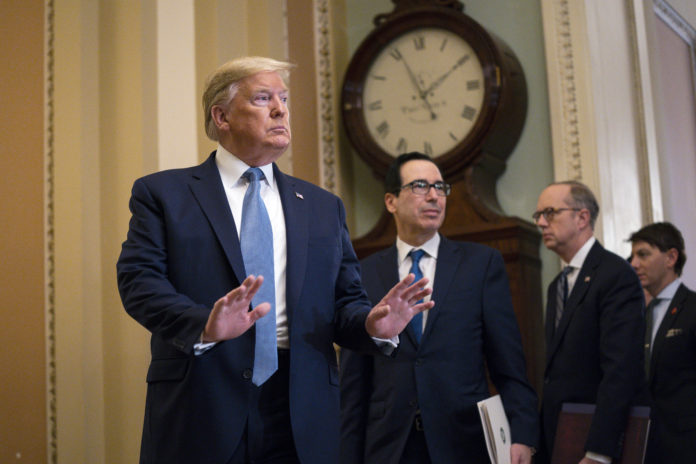
WASHINGTON (AP) — The government has a palette of options it can use to shore up an economy imperiled by anxiety over the coronavirus outbreak. They start with the “middle-class” payroll tax cut that President Donald Trump is suggesting and include quicker, more targeted federal aid as well. But the options could come with pitfalls and may raise unrealistic expectations.
The White House and Congress have started wrangling over measures to spark the wounded economy, as fear around COVID-19 has threatened to tip it into recession. The crisis of confidence over the virus, with more than 118,000 people infected worldwide and 29 deaths in the U.S., is keeping American consumers — the spending engine of the economy — away from public places like shopping malls, grocery stores and movie theaters.
Beyond the payroll tax cut, stimulus measures that may be considered include aid to wage earners missing work because of illness or quarantine who don’t receive sick pay, special loans for small businesses, subsidies or tax relief to affected industries like airlines, hotels and cruise ships, and aid to certain parts of the country bearing the brunt of virus illnesses and deaths.
Aiding wage earners who don’t receive sick pay is a top priority along with the payroll tax break, Larry Kudlow, a senior economic adviser to Trump, told reporters at the White House Tuesday evening. He said they’re also considering assistance to small and medium-size businesses and possibly to some distressed industries.
“Everything the Trump administration has proposed so far is way too small,” says Simon Johnson, an economics professor at MIT’s Sloan School of Management who’s an expert on financial and economic crises.
Johnson wants to see emergency sick pay covered substantially by the government, overtime paid to health care workers, and a massive transfer along the lines of a proposal by a top economic adviser to President Obama. Congress would send every American adult $1,000 and $500 to every child under Jason Furman’s proposal, at an estimated ultimate cost to taxpayers of $350 billion.
Trump’s signature proposal of a payroll tax cut has spurred criticism from both conservatives and liberals, and it met bipartisan resistance Tuesday on Capitol Hill.
“It’s a very untargeted measure,” said Joseph Stiglitz, a Nobel laureate economist who teaches at Columbia University. “Some Americans are at the brink. They need to show up to work to feed their families.”
That means infected people could come to work in restaurants, extending a vicious cycle, he said. Help is needed to cover low-income workers’ sick leave.
At a White House briefing Monday, after another day of stock market convulsion drove the Dow Jones Industrial Average to its steepest one-day drop ever of 2,013 points, Trump put forward a possible payroll tax cut as a centerpiece of his team’s emergency economic plan.
Kudlow said the White House team is looking at a suspension of all payroll taxes, paid by employers and workers, through the end of the year. “It’s a bold move; it’s a very bold move. And this is a bold president,” he said.
It’s an idea that Trump considered last summer to avert an economic slowdown, as some experts warned the U.S. was heading for a pullback that could hurt his reelection chances. But Trump quickly reversed course and touted the economy’s strength, blaming the Federal Reserve and its Chairman Jay Powell for not cutting interest rates.
With payroll taxes, employers deduct some money from workers each pay period, normally as a percentage of their salary. It goes toward advance payment of income taxes, and contributions to Social Security and unemployment and disability insurance.
Cutting that may sound like a winner, especially in an election year.
But critics say such a cut would be unfair because it favors higher-income wage earners — not gig workers, people knocked into joblessness by economic dislocation or coronavirus quarantine, and others with only part-time jobs or who are self-employed.
At any rate, some experts say, no matter how much emergency cash might be freed up by the government, consumers may not spend it to jump-start the economy if they’re afraid to open their doors.
“It’s a different kind of shock,” said Kenneth Rogoff, a professor of public policy and economics at Harvard who’s an expert on financial crises across time. “You don’t have enough money to buy stuff and the government makes a transfer to you, that’s great — but not if you’re hiding under the bed.”
Instead, critics point to solutions that target federal aid directly to the health care sector and efforts to contain and fight against the coronavirus: for manufacturing face masks and virus test kits, developing vaccines, adding new hospital ICUs and ventilators.
Funneling support to certain industries such as airlines, hotels and the oil business could unleash a torrent of special-interest jockeying on Capitol Hill as companies seek special status and exemptions, and lawmakers champion businesses in their states and districts.
Trump on Tuesday said the cruise industry and airlines are facing particular difficulties and added: “They’re two great industries and we’ll be helping them through this rough patch.”
As reported by Vos Iz Neias
